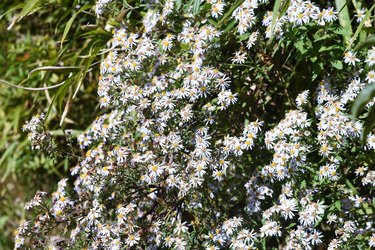
Wild aster (Symphyotrichum divaricatum, Aster exilis, Aster subulatus), also known as annual aster and lawn American-aster, is a warm-season, broadleaf annual that grows throughout the United States. Although it bears white, daisy-like flowers, this prolific seeder often gets weedy in lawns when left to its own devices. You can remove unwanted wild aster by using mechanical and chemical methods.
Pull Wild Asters By Hand
Video of the Day
Weeding out unwanted wild asters before they go to seed generally kills and controls small patches of them. The plants are simple to remove from moist soil. So either waiting until after a rain or dampening the soil makes pulling the asters out of the ground by hand easier than it would be otherwise.
Video of the Day
Wearing gardening gloves, grasp one of the aster's at the base of its main stem as close to the soil line as possible. Hold down the soil with your other hand, and pull the entire plant out of the ground. Discard pulled wild asters in a covered trash bin. Keep an eye on the weeded area, and remove all new wild aster plants that pop up.
Choose a Post-Emergent Herbicide
Selective, broadleaf, post-emergent herbicide can kill wild aster plants without harming many varieties of turfgrass. Products containing 2,4-D, dicamba, mecoprop or any combination of those active ingredients are readily available to homeowners and can be used safely on lawns with established Kentucky bluegrass (Poa pratensis) and tall fescue (Festuca arundinacea), which are hardy in U.S. Department of Agriculture plant hardiness zones 2 through 7. Bermudagrass (Cynodon spp., USDA zones 7 through 10) and zoysiagrass (Zoysia spp., USDA zones 6 through 9) may suffer from temporary yellowing of the blades right after the treatment, however.
Broadleaf post-emergent herbicide is available in various formulations, including a ready-to-spray form that requires only hooking up a hose, but carefully read and follow your herbicide's label directions before using the product; some herbicides need to be diluted in water before they are used.
Spray the Herbicide
Herbicide chemicals can cause skin and eye irritation. So reduce your risk of contact with them by wearing goggles and clothing that covers all of your skin when handling and applying herbicide. Keep people and pets out of the treatment area until the spray dries. Dicamba, 2,4-D and mecoprop are systemic herbicides, which means plants absorb them through leaves and the chemicals move down to the roots.
Prevent the chemicals from washing off foliage by spraying only when no rain is forecast for 24 hours. Avoid watering the treatment area for at least 24 hours as well. Don't mow your lawn for two to three days before and after an herbicide application so the plants have plenty of leaf surface area to absorb the chemicals.
Although the herbicide has little activity in soil, broadleaf ornamental plants can be damaged by drifting herbicide spray. Reduce the risk of harming valued plants by spraying herbicide on windless days. The herbicide solution must make direct contact with the wild asters in order to work effectively. Wild asters generally require two to four treatments at 10- to 14-day intervals. Make your first herbicidal treatment just after the weeds emerge in May or June.
Spread Corn Gluten Meal
Corn gluten meal can kill wild aster when used as a pre-emergent herbicide. Unlike other kinds of pre-emergent treatments, corn gluten meal allows aster seeds to germinate, but the resulting plants don't develop normal roots, and so those plants dry and die.
Make your first yearly application of corn gluten meal in late March to mid-April and the second application in mid-August to mid-September. Follow the instructions on your corn gluten meal product's label. Most products recommend using 12 to 20 pounds of corn gluten meal granules for every 1,000 square feet of lawn space.
Evenly apply the granules to your lawn by using a spreader. After irrigating the treated area, allow the soil to dry out for a short time so the meal has a chance to kill the wild aster roots. Corn gluten meal is a non-selective herbicide, which means it affects all kinds of plants. Avoid using corn gluten meal in areas you recently seeded or plan to reseed turfgrass.
- Oklahoma State University Cooperative Extension Service: Controlling Weeds in Home Lawns
- Missouri Botanical Garden: Pesticides -- Corn Gluten Meal
- Iowa State University Extension: Corn Gluten Meal -- A Natural Weed and Feed for Lawns and Gardens
- Fine Gardening: Six Tips for Effective Weed Control
- Cornell University, Weed Ecology and Management Laboratory: Pulling Weeds